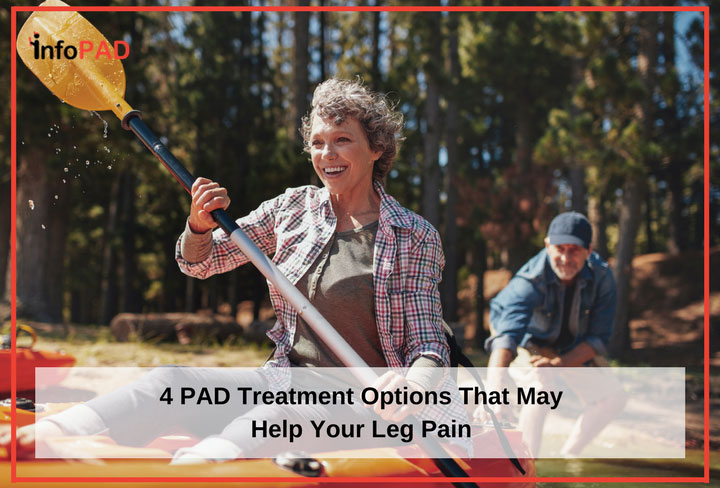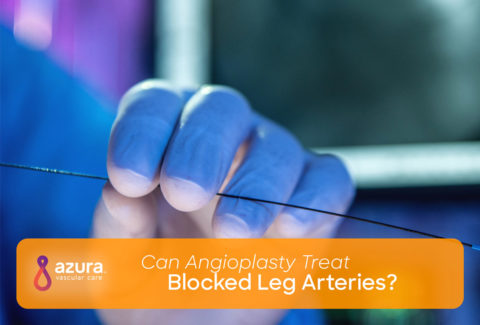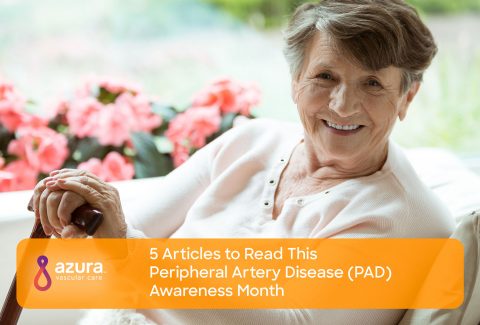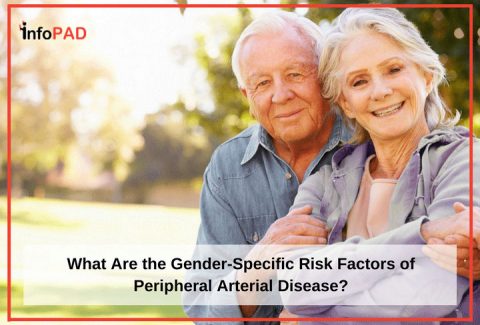
Peripheral artery disease (PAD) can cause severe discomfort, making it difficult to manage even the simplest chores.
Fortunately, there are a number of treatment options available for you if your recent screening indicates you may have PAD. The first step in treating PAD is to consult with your physician, who will perform a few diagnostic tests that may include ultrasound imaging, an Ankle-Brachial Index (ABI) test, Pulse Volume Recording (PVR) exam, or an angiography to determine if you have PAD.
Once your doctor has diagnosed you with PAD, he or she will begin to recommend PAD treatment options. Some treatments seem to combine more than one option, such as medication and lifestyle changes. By attacking the disease on two fronts, it may be possible to reduce pain while lowering the risk for further damage. Here is an overview of four of the most commonly recommended PAD treatment options, ranked from least invasive to most:
4 of the Most Common PAD Treatment Options
1. Lifestyle Changes
Often, simple lifestyle changes can be the most effective peripheral artery disease treatment option. Here are a few changes you can make to reduce the symptoms from PAD.
Quit Smoking
Patients who smoke are at a higher risk of developing PAD and experience a faster progression of the disease. According to the National Heart, Lung, and Blood Institute at the National Institutes of Health, smoking can damage blood cells and reduce the efficiency of your heart in pumping blood, making plaque a much more serious obstacle to blood circulation. Quitting smoking now can help you manage the progress of this disease or avoid it entirely.
Change Your Diet
Foods high in saturated fats can contribute to the development of plaque in the bloodstream and increase both the risk and the severity of PAD. Eating heart-healthy foods like fresh fruits and vegetables can dramatically reduce the effects of the disease. By avoiding high fat items and increasing the amount of raw vegetables and fruits in your diet, you can reduce your risk for a number of serious ailments, including type II diabetes and cardiovascular disease, all of which are contributors to PAD.
Exercise
Be sure to work out regularly. Cardio workouts can help lower cholesterol and blood pressure, and can reduce the risk for plaque build-up in blood vessels and help you maintain a healthy weight. This can significantly lessen your chances for developing PAD.
Find out more about participating in a peripheral artery disease exercise program.
2. Taking Prescription Medication
Sometimes changing your habits isn’t enough. If you have a medical condition that’s contributing to your PAD, discuss it with your doctor. There may be a prescription medication intervention that can make a major difference in your treatment. You’ll want to be sure to stay in close contact with your doctor though, in the event that the medication isn’t working as it should.
Statins for High Cholesterol
Statins are prescription drugs designed specifically to lower cholesterol. These medications are often prescribed for patients with PAD. High cholesterol can contribute to the build-up of plaque in blood vessels, causing poor circulation that can directly lead to PAD in vulnerable individuals. Addressing this problem promptly can improve heart function, allowing blood to circulate to extremities and reducing the risk for the pain and numbness caused by PAD.
High Blood Pressure & High Blood Sugar
Prescription blood pressure meds can provide some protection against the worst effects of PAD. You should also keep your blood sugar under control, as uncontrolled diabetes is a factor in many PAD cases. Reduced circulation is a common side effect of diabetes; taking steps to maintain healthy blood sugar levels can help you avoid a number of serious circulatory issues.
Related: Find out how high blood pressure and high cholesterol may lead to PAD
Low-Dose Aspirin
Although not a prescription medication, low-dose aspirin therapies can be used as a PAD treatment – helping prevent blood clots from forming by thinning the blood to a slight degree. This can reduce blockages in blood vessels and allow improved circulation to the feet, legs, hands, and fingers. The pain-killing effect of aspirin can also provide some relief for those individuals who routinely experience moderate to severe leg and foot pain as a result of PAD.
3. Minimally Invasive Procedures
If lifestyle changes and prescription medication treatments aren’t doing enough to ease your symptoms, it may be time to ask your doctor about some of the non-surgical treatment options that are available to you. If your doctor hasn’t discussed some of the following minimally invasive procedures, you should bring them up. Surgery isn’t always the best option, and depending on the severity of your case, you may be better off with one of these treatments and have a substantially quicker recovery time than you would typically have with surgery.
Angioplasty
Angioplasty is a procedure in which a small catheter is inserted into an artery and carefully maneuvered into the spot where the blood flow is being restricted. The balloon on the tip of the catheter is then expanded to press plaque against the walls of the artery, creating a wider channel through which blood can flow more easily.
Atherectomy
Much like angioplasty, atherectomy begins with the insertion of a catheter into the affected artery. Once the catheter has been guided to the appropriate spot, a small rotating blade actually shaves away the plaque to clear the blockage. The atherectomy device collects the plaque, allowing it to be removed from the body when the device is withdrawn.
Stenting
Stents are small mesh tubes that are inserted into the arteries using a minimally invasive method similar to that used in atherectomy and angioplasty procedures. These tubes remain in the artery to hold it open, preventing blockages where they are positioned.
4. Traditional Surgery
In-hospital surgical procedures aren’t the most common peripheral artery disease treatment options. In fact, surgery often can be a last resort, performed only for the most severe cases where lifestyle changes, medication, and minimally invasive procedures have proved ineffective. It’s important to understand that if you require a surgical procedure, it will likely result in a longer stay in the hospital and a longer recovery period. For major blockages, however, bypass surgeries may be recommended to ensure that the blockage is cleared and serious risks to health are addressed effectively.
Aortobifemoral Bypass
This surgery is an option when PAD is affecting the major abdominal artery and the arteries that branch from it.
Endarterectomy
The least common surgery for PAD treatment, endarterectomy is usually performed on your groin and upper thigh, on the large femoral artery. The surgery removes the plaque from arteries, ultimately increasing blood flow to the leg, and it can be performed at the same time as an angioplasty or bypass surgery.
Fem-Pop Bypass
Arteries below and above the knee that are affected by PAD may need this surgery.
Femoral-Tibial Bypass
Femoral-tibial bypass is a potential solution for PAD sufferers who experience pain in their feet and lower legs.
RELATED: Comparing PAD Treatments: Minimally Invasive vs Bypass Graft Surgery
What You Should Do Next
Consulting your physician is the first step toward determining how you should proceed in dealing with your PAD-related pain. You should understand your treatment options so you can make the best decision regarding your care. If you need help finding a doctor you can search for one here.


